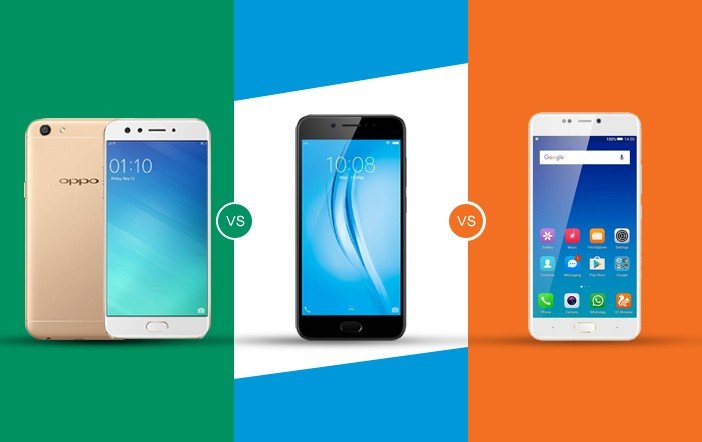India is one of the key smartphone markets in the world. The smartphone makers are bringing their latest and innovative products to the Indian market. While so, the Chinese OEMs like Vivo, Oppo and Gionee are focussing on a niche audience with its selfie-centric range of smartphones. Now, Oppo has just launched its new selfie-centric smartphone in the Indian market called as the Oppo F3 which will go one-on-one with the likes of Vivo V5s and Gionee A1.
Here, we have compared the three selfie-centric smartphones based on their price, specifications, and features.
Price
The newly launched Oppo F3 will be made available for purchase from May 13, on Amazon India and offline retail stores at a price of Rs 19,990. Vivo’s latest mobile, the Vivo V5s will be made available on May 6 at a price of Rs 18,990. On the other hand, the Gionee A1 is already available in the market at a price of Rs 19,999.
Display
The all three smartphones come with a 5.5-inch display and 2.5D curved glass on top. However, the resolution and display panel of the devices are different. The Oppo F3 features a full HD (1080×1920 pixels) TFT IPS panel, the Vivo V5s features an HD (720×1280 pixels) display, and the Gionee A1 comes with a full HD (1080×1920 pixels) AMOLED display. The Gionee A1 and Oppo F3 are leading the display section with higher resolution support, whereas the Vivo V5s stays behind with HD panel.
The selfie-centric smartphone shipments in Q1 2017, had grown 15 percent. And, Oppo has a market share of 23.6 percent in this shipment figures. – Counterpoint Research.
Specification
Coming to the specifications, the Oppo F3 comes equipped with a 64-bit MediaTek MT6750T octa-core processor paired with 4GB of RAM and 64GB of internal storage with a dedicated microSD card slot for further storage expansion. It is a dual SIM mobile and runs on Android 6.0 Marshmallow OS. It packs a 3200mAh battery with fast charging technology support.
The Vivo V5s, on the other hand, is powered by a MediaTek MT6750 processor paired with 4GB of RAM and 64GB of internal storage with micro SD card support via hybrid SIM card configuration. The device runs on Android 6.0 Marshmallow OS and is powered by a 3000mAh battery.
Have a Look At: Latest Oppo Phones Below Rs.20000 in India
Lastly, the Gionee A1 is equipped with a 64-bit, 2GHz MediaTek Helio P10 octa-core processor paired with 4GB of RAM, 64GB of internal storage, and external storage of up to 256GB via microSD card. The handset runs on the latest Android 7.0 Nougat OS with Amigo OS skin on top. The handset boasts a 4010mAh battery.
All three smartphones come with connectivity options such as dual-SIM support, 4G VoLTE, Wi-Fi, GPS, and Bluetooth. In addition, the Vivo V5s and Gionee A1 supports USB OTG.
Camera
The key highlight of all three smartphones is its selfie-centric features. The Oppo F3 smartphone offers a unique dual front-facing camera setup out of which one is a 16MP standard sensor and the other one is an 8MP wide-angle lens. At the rear, there is a 13MP camera with PDAF and LED flash.
The Vivo V5s offers a 20MP selfie shooter with Moonlight Glow LED light. There is a 13MP primary rear camera with LED flash.
Lastly, the Gionee A1 offers a 16MP selfie snapper with LED flash and aperture of f/2.0. At the rear, it has a 13MP camera with aperture f/2.2, PDAF, and LED flash.
Conclusion
Overall, the competition in between these three smartphones is truly going neck-to-neck. However, the Oppo F3 is on the upper hand among the other two smartphones due to its dual front-facing camera module for capturing selfies and group selfies. Besides the group selfie features, Oppo F3 has certainly a good set of specification and features. On the other hand, Gionee A1 is also a good option with nice selfie-centric features and a whopping 4010mAh battery capacity.
Also Check: Gionee Phones with 4GB RAM in India
Verdict
The Oppo F3 is obviously the winner in the list during the initial comparison based on the specification sheets. However, if a good battery life is your preference, then you can go for Gionee A1 without any doubt.
